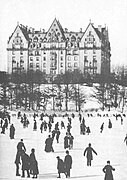Edward Severin Clark
Edward Severin Clark (July 6, 1870 – September 19, 1933)[1] was an American businessman, and the owner of the New York City apartment building The Dakota.
Early life
Clark was born on July 6, 1870, in
His paternal grandfather, Edward Cabot Clark, was Isaac Singer's partner in the Singer Sewing Machine Company, and built Manhattan apartment buildings, including The Dakota. His grandfather died during construction of The Dakota and bequeathed it to Edward, his 12-year-old grandson and namesake.[4]
Career
Edward and one of his younger brothers,
Another brother,
Personal life
Edward, who never married nor had children, died at his farm in Cooperstown on September 19, 1933.[1]
"Fenimore House," the mansion he built for himself overlooking Otsego Lake, is now the Fenimore Art Museum. His former dairy farm is now the Farmers' Museum.[6] He donated the sculpture The Great God Pan (1899) by George Grey Barnard to Columbia University in 1907.[7]
Gallery
-
"Fernleigh" (1869) Edward Cabot Clark residence, Copperstown, New York
-
The Dakota, from Central Park Lake (1880s)
-
The Great God Pan (1899) by George Grey Barnard, Columbia University
-
"Fenimore House" (1932), now Fenimore Art Museum, Cooperstown, New York
-
Farmers' Museum, Cooperstown, New York
References
- ^ a b "EDWARD S. CLARK, CAPITALIST, DIES, 63; Coopersiown in Mourning for BenefactoruSoil From His Farm to Cover Coffin" (PDF). The New York Times. September 20, 1933. Retrieved April 25, 2019.
- ISBN 0307263479
- ^ "FUNERAL OF MRS. POTTER.; Bishop Greet Officiates at Services for the Widow of the Late Bishop" (PDF). The New York Times. March 15, 1909. Retrieved April 25, 2019.
- ^ Stephen Birmingham, Life at The Dakota: New York's Most Unusual Address, (Open Road Media, 2015).
- ^ (no author), The History of the Clark Sports Center; The First 125 Years, (PDF) from All Otsego.
- ^ Henry Naccari, "Baseball Hall of Fame is top draw but hidden treasures can also be found in Cooperstown," North Country News, July 30, 2003.
- ^ "George Grey Barnard and Pan", from Columbia University Libraries.





